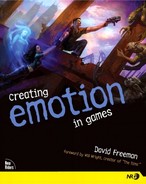If one person can have depth, so can a bunch of 'em.
This chapter
focuses on techniques that make groups—groups as small as a platoon or as large as a race or culture—embody a feeling of emotional depth.
Just as there are ways to give depth or layers to an NPC, there are ways to do the same for a group or a culture.
We actually encountered a few in the last chapter among some of the tribes of post-Apocalyptic America, but I didn't point them out at the time. Let's look at those tribes again now, and focus on the Group Deepening Techniques.
Among the Blades, the leader doesn't command his men from a distant outpost; he spearheads the attack. Thus, they have Honor. Also, their beautiful training routines, or katas, show Aesthetics. This was also true of the Tabrene, who had a tradition of music, literature, and poetry.
The Korimutay hide. They're Mysterious. Also making them mysterious is the secret they hide: Why are they here voluntarily?
Additionally, the Korimutay have some special rapport with nature and can even transform it to some degree. Therefore they are Mystical or Spiritual and have mystical or spiritual abilities. You might say that their incredible accuracy with their weapons has either a spiritual or aesthetic quality.
All these characteristics can give emotional depth to a group.
Let's examine techniques for adding depth to a group in the context of a hypothetical game.
In our example game, a time-travel mishap delivers you to the time of Cro-Magnons, who fight off Wooly Mammoths and other hominids who've got their own ideas about being progenitors to man.
Initially, the game sets up situations that would lead you to think that these Cro-Magnons are fairly dumb and shallow. But then, as you get to know them as a group and as individuals, you discover that certain aspects of their culture give them depth.
They have a mythological explanation of the world that, although not very scientific, has more emotional and spiritual truth than perhaps even our own world-view.
For instance, they claim that children are inhabited by river spirits, which is why they are free, playful, and always on the run. When children get older, the river spirits leave, replaced by tree spirits, which is why adults are more inclined to stay in one place.
The way a tree offers shelter with its green canopy, adults give shelter to their children. But, as water nourishes the tree, the river spirits in the children, in turn, bring life to the trees that are the adults. Thus their proverb, “The sound of children is life.”[1]
Obviously, merely believing in spirits doesn't make an individual or group “deep.” But being able to think in terms of metaphorical relationships based on observation of subtle energies would certainly show wisdom and thus give the group “depth.”
If there's a beautiful sunset, members of the clan gather to watch in complete and utter silence and awe. The children watch too.
Also, the clan creates beautiful cave paintings.
Suddenly, by applying a few Group Deepening Techniques, the group no longer seems possibly unintelligent or shallow.
Of course, as you get to know various NPCs among the group, if a number of them possess either NPC Deepening Techniques (Chapter 2.2) or Dialogue Deepening Techniques (Chapter 2.4), their depth will also rub off on your feelings about the culture as a whole.
This talk about Deepening Techniques may make it sound like a game is deficient if such techniques are lacking. That's not the intended conclusion. Most of the tools of Emotioneering are optional.
If a game is purposely designed to be fun and off-the-wall, the designers might choose not to use Deepening Techniques of any kind whatsoever. That having been said, you'll note that in even the silliest of Hollywood films (Liar, Liar, for instance), there are almost always moments of “depth” to give the story a periodic emotional anchor. These moments are usually designed to sneak up and grab us when we least expect them.
[1] It goes almost without saying that this spiritual background is a lot of information to relay in a game. Those who enjoy the extra level of detail and depth will truly appreciate your efforts here. But because some players couldn't care less (since their primary reason for playing will be the gameplay and not any story elements), ideally your game should accommodate both.
One way of dealing with this is to not force information like this down players' throats; don't make learning information about these tribes' beliefs and practices something that all players must experience in order to progress through the game. Instead, it can be made available in some way or another just to those who seek it out.
Some designers feel that every piece of information a player learns should influence how the game is played or how the story unfolds. But this is simply one ideal. If the information colors the player's emotions, then I would say that it does influence the game. If liking children makes these people more likable to the player, then that also influences the game.
This doesn't mean that it isn't worth striving to have all information that is learned by the player be useful in a more active way in the game.
